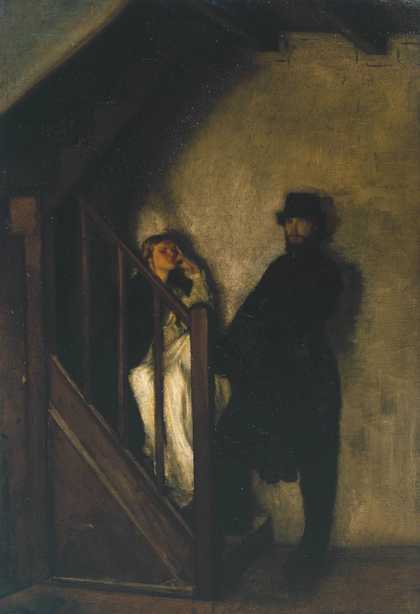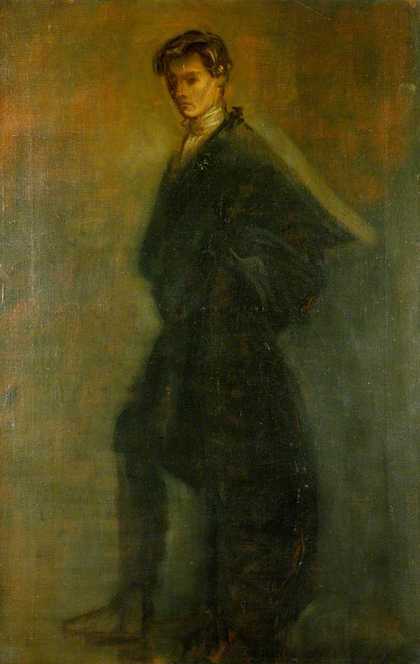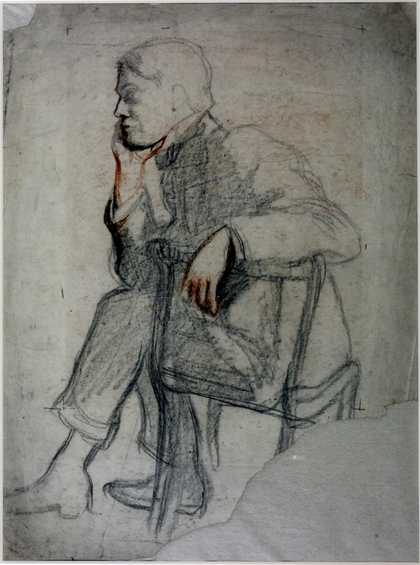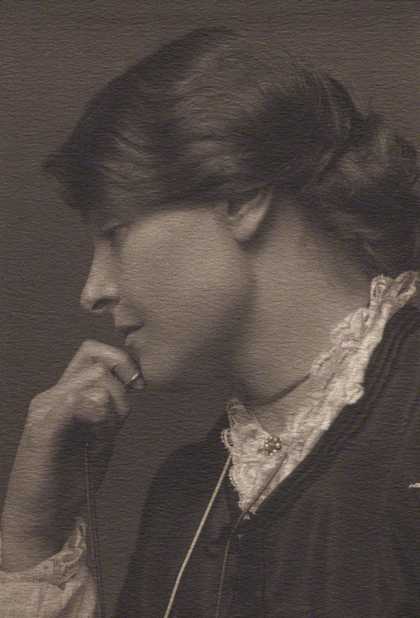While not directly referencing any specific scene in Henrik Ibsen’s play A Doll’s House (1879), Rothenstein’s choice of title for his 1899 work The Doll’s House 1899 (Tate N03189; fig.1) is telling in its allusion to the subject and narrative of modern theatre. In connecting his work with Ibsen, Rothenstein was directly associating himself with contemporary developments in the theatre and, by extension, identifying himself as an intelligent participant in issues relating to modern painting. The painting, which depicts Rothenstein’s actress wife Alice and fellow artist Augustus John, is a curious and ambiguous work which, as contemporary critics noted, reflects the general ambience and narrative of Ibsen’s narrative: ‘the design is arresting, the colour quiet and restrained, but in all the quiet there is a sense of impending drama which seems the quintessence of Ibsenism.’1

Fig.1
William Rothenstein
The Doll’s House 1899–1900
Tate
Rothenstein had a long-standing interest in the theatre, completing portraits of such figures as Edward Gordon Craig in the role of Hamlet (fig.2), Ellen Terry, George Bernard Shaw and the critic William Archer, as well as planning a portrait of Ibsen in the 1890s.2 His portrait of Gordon Craig, while echoing Whistler’s portrait of Henry Irving, seems to prefigure in its use of a strong outline, strident pose and direct gaze the figure of Augustus John from The Doll’s House. Rothenstein’s theatrical interests saw him, in 1898, work with Walter Sickert on portraits of the actresses Irene Vanbrugh and Hilda Spong in their roles as Rose Trelawny and Imogen Parrot from Arthur Wing Pinero’s Trelawny of the ‘Wells’ (1898). The play was first performed at the Royal Court Theatre in Sloane Square in London on 20 January 1898 and, as acquaintances of Pinero, both Rothenstein and Sickert were in the audience for the first night:
Through Miss Terry, Henry Irving and the Trees, I got many tickets for first nights in those days, and saw many plays. When Pinero’s Trelawny of the Wells was put on at the Court Theatre, I went with Sickert to see this enchanting piece. Here was a play which seemed written for our delight. What fun it all was; and how enchanting the costumes! And such a chance it provided that Sickert asked Miss Hilda Spong – a magnificent creature who acted a part – to sit for him; while I approached Irene Vanbrugh. Miss Vanbrugh took infinite trouble, and endured many sittings. Sickert had Miss Spong photographed, and from a small print and with few sittings he achieved a life-size portrait.3

Fig.2
William Rothenstein
Edward Gordon Craig as Hamlet in Hamlet by William Shakespeare 1896
© Victoria and Albert Museum, London
Certainly Rothenstein’s interests favoured the modern theatre; he was a staunch supporter of George Bernard Shaw, recalling that in September 1903 he received a package which contained a copy of Shaw’s Man and Superman (1903): ‘the best play Shaw had hitherto written’.4 Shaw’s plays were frequently staged at the Royal Court Theatre in the early 1900s, where ‘Like every other intelligent playgoer, William had been drawn to Granville-Barker’s productions’.5 Rothenstein was, however, uncertain about Granville-Barker’s direction:
I was critical of the way in which Barker produced Shaw’s plays at the Court Theatre. In the stage scenes, which represented commonplace rooms, there was none of the fun of Shaw’s dialogue; they were just unintelligently dull. I told Barker what I felt: that irony should be shown in scenes as it was in dialogue; that there were plenty of young artists who could design scenes and dresses with point and meaning, even for realistic plays.6
Rothenstein’s interest in the theatre was undoubtedly influenced by the growing interest in the works of Ibsen, particularly after the premiere of Ibsen’s Ghosts which opened at the Royalty Theatre in London’s Soho on 13 March 1891. Although relatively well known in Britain since the late 1870s, Ibsen’s work was not generally popular with audiences or critics. The first noteworthy performance of Ibsen in England came with Charles Charrington and his wife Janet Achurch’s A Doll’s House which was performed at the Novelty Theatre in Holborn, London, on 7 June 1889, where it attracted strong criticism in The Queen:
Ibsen enforces his extravagant views by means of the most unpleasant set of people it has ever been the lot of playgoers to encounter, and, furthermore, discusses evils which we unfortunately know to exist, but which it can serve no good purpose to drag into the light of common day … We do not go to the theatre to study such social evils as Ibsen delights to discuss in his cynical, uncompromising manner.7
The Illustrated Sports and Dramatic News took a similar line:
It is a fact that A Doll’s House, Mr William Archer’s translation of a work of art by Henrik Ibsen, has been pretty severely criticised … I never sat out a play more dreary or more illogical as a whole, or in its details more feeble and commonplace. Speaking of the details first – they are purely and simply realism done to death. It is as though someone had dramatised the cooking of a Sunday dinner … I can’t imagine a more tedious time that I passed with A Doll’s House.8
Rothenstein’s friend, the aforementioned William Archer, had first become aware of Ibsen’s work in the early 1870s and became his chief translator in 1878. Indeed in 1891 he was confident enough to state that:
The theatrical world of today is far more truly alive than it was ten, or even five years ago. We are talking, and perhaps even thinking about the drama with unexampled fervour and pertinacity … 7th June, 1889, the date of the production of A Doll’s House at the Novelty Theatre, was unquestionably the birthday of the new movement.9
Despite initial criticism the play eventually became a mainstay of the London theatre and was produced a number of times between 1891 and 1897, including matinee performances at Terry’s Theatre on 27 January 1891 and the Criterion Theatre on 2 June 1891 as well as three performances at the Opera Comique between 7 and 12 November 1894. It also attracted a performance by the Italian actress Eleanor Duse at the Lyric Theatre between 9 and 17 June 1893 which Archer thought ‘wonderfully impressive and beautiful … Her opening scenes …. struck me as the very perfection of natural acting, her gaiety being spontaneous, effervescent, iridescent, so to speak, without being in the least overdone’.10 The play was even the subject of a parody: Ibsen’s Ghost: or, Toole Up to Date, a popular spoof of A Doll’s House. Ibsen’s Hedda Gabler (1890), meanwhile, ran for twenty-seven performances, at J.L. Toole’s Theatre, between 20 May and 27 June 1891.
For serious theatre lovers, Charles Charrington and Janet Achurch’s productions remained the most renowned. Achurch would later play Nora at the Avenue Theatre, in Archer’s translation, for thirty performances between 19 April and 20 May 1892 and the Royalty Theatre for fourteen performances between 11 and 25 March 1893, where Archer thought she managed to capture the part’s ‘melancholic dignity, the subdued intensity of feeling’.11 The 1897 Independent Theatre Society’s production at the Globe also starred Achurch as Nora:
she realises fully the earlier phases in the stage presentation of the frivolous, irresponsible, macaroon-nibbling baby wife with that little knowledge of business which is a dangerous thing … strange fancies of Ibsen’s ‘New Woman from the North’.12
Rothenstein first saw a signed photograph of the actress at his friend Charles Conder’s (fig.3) apartments as a young artist and, sometime afterwards, saw her perform on stage as Nora.13 Indeed, it was Conder who had first instilled in Rothenstein an interest in the modern theatre: ‘Conder … talked to me of Ibsen, of whose plays I knew nothing, and of Janet Achurch, whom he had known in Australia, and of her wonderful acting in The Doll’s House’.14 Without doubt, the play, with its interest in naturalism and scenic realism, was a key influence on Rothenstein, as he recalled: ‘We were all mesmerised by Ibsen in those days’.15

Fig.3
William Rothenstein
Charles Conder 1893
Chalk on paper
508 x 381 mm
Tate
© The estate of Sir William Rothenstein. All Rights Reserved 2010 / Bridgeman Art Library
It was Rothenstein’s friend Max Beerbohm, the half-brother of the actor and manager Herbert Beerbohm Tree, who fully introduced him to the world of the theatre. From 1895 onwards, however, his closest link to the stage was his future wife, the actress Alice Kingsley. Alice Kingsley was the stage name of Alice Knewstub, the eldest of three daughters of the artist Walter Knewstub and his wife, the former artist’s model Emily Renshaw. Walter Knewstub had moved in Pre-Raphaelite circles, studying under Dante Gabriel Rossetti and working with Ford Madox Brown. His career never really took off, however, and the strain of having eight children (only four of which survived) hit the couple hard, ensuring that Alice was expected, from an early age, to help support her siblings.16 She did this by turning to the stage, where her natural good looks, inherited from her mother, attracted attention.17 According to her only brother John, who would go on to found the Chenil Gallery in London’s Chelsea, Alice was largely responsible for keeping the household going: ‘what would Papa have done without you?’ he asked in 1906, ‘Indeed what should we all have done?’.18
By the time Rothenstein met her, at a reception given in honour of the Belgian playwright Maurice Maeterlinck in 1895, Alice was twenty-six. Her thoughts on marriage have not been recorded, but as an independent young woman who, at least initially, was keen to put her profession before romance it seems likely that she would have been in sympathy with – if not necessarily a vocal advocate of – what is now referred to as the New Woman movement.19 Rothenstein will have realised soon after meeting her that she was not a shrinking violet or a personality content to hide behind her looks. By all accounts, Alice Knewstub was a forthright individual, who held sometimes caustic opinions on a wide variety of subjects.
Although never progressing to major parts Alice was widely regarded as a competent actress. According to the playwright Sydney Grundy, writing in 1897, ‘For a certain class of part Miss Kingsley has natural qualifications which are rare in any country’.20 Prior to her marriage to Rothenstein in 1899 she had performed a number of small roles, principally for J.L. Toole’s company, and had established herself as a pleasing talent, typically in light comic operas. In a review of her performance as Angelica in William Barrymore’s farce The Secret, the critic for the Era noted: ‘Miss Alice Kingsley delivered Angelica’s lines with distinctness, expressiveness, and ladylike composure.’21 A rather more brief review in the same publication accompanied her performance as Polly Primrose in Blue-Eyed Susan: ‘Miss Alice Kingsley … had not much to do but to wear smart costumes and look pretty, and so far succeeded.’22 The late 1890s saw Alice take on a number of small roles in London including that of Mistress Quickly in Herbert Beerbohm Tree’s production of Shakespeare’s Henry IV, Part I c.1597 at the Haymarket and Zoe in Sydney Grundy’s The Musketeers, an adaption of Alexandre Dumas’s 1844 novel The Three Musketeers, which played at Her Majesty’s.23 Alice also acted in Grundy’s Sowing the Wind (1893) at the Comedy Theatre in March and April 1895: ‘Miss Alice Kinglsey makes the most of the part of Maud Fretwell’, observed a critic for the Era.24 Alice had an early experience of modern theatre when she performed as Juliet in Charles Reade’s adaption of Émile Zola’s L’Assommoir (1877), retitled Drink for English audiences, at Drury Lane in 1891. The play, which according to the Saturday Review enjoyed a ‘great pit and gallery popularity’, was noted for its theatrical realism.25
The couple’s early relationship was not without its problems. Rothenstein was frustrated by Alice’s seeming indifference: ‘I shall be glad to see you again, because I love you. But your affection for me is not so entirely clear to me, as I might, in my vanity wish’.26 He was also somewhat doubtful of his own appeal: ‘How cruel you are again. I expected you all afternoon, and then waited in until late, awaiting a line – nothing. Was it merely forgetfulness, or neglect, or refined cruelty? … Won’t you come to lunch? Or have you been comparing letters again, to find I am but a dull dog after all?’27 Alice’s famous beauty must have proved somewhat unnerving for the young artist, whose own looks elicited less welcoming attention (‘the smallest man I’d ever seen’ was how Alice recalled their first meeting).28 While interested in the theatre Rothenstein was also clearly envious of the hold it had over his beloved – if not jealous of the admiration she received from audiences. A letter from 1896 suggests something of Rothenstein’s concerns as well as Alice’s own dissatisfaction with her career: ‘Dearest – you must not think me too unsympathetic over your theatrical troubles – for indeed I am worried about them – only there is so much that is distasteful to me in your profession, and there are certain things, and people especially so’.29 Coming from an upwardly mobile middle-class German-Jewish community in Bradford, Rothenstein was naturally anxious as to what people might make of his relationship with the Catholic daughter of a relatively poor London artist, currently serving in a ‘distasteful’ profession. If Alice was a New Woman, was he a New Man, or just a provincial, bourgeois ‘dull dog’? Could he handle or temper her independent spirit? Although he moved in bohemian circles, Rothenstein was frequently accused by fellow artists of being eminently sensible, if not a little ‘strait-laced’.30
Rothenstein was certainly rather cautious about informing his parents of his impending marriage. In a letter written shortly before his marriage he wrote:
I am sure you will like her, and that she will love you both very dearly. I have been a little cowardly about her, as I write this, indeed, since I made up my mind as to my duty … London life is so complicated, & my dear Alice’s position so hard & lonely, that I am looking forward to giving her such a home as I can.31
Fortunately, their romance weathered these early gauche moments and, following their marriage on 11 June 1899, the newlyweds honeymooned in Dieppe before renting a small cottage in Vattetot. While there they were visited by William’s brother Albert and the artists Augustus John and William Orpen, both of whom were busy working on sketches of Shakespeare’s Hamlet for the Slade School competition.32 Included among this rather celebrated group was Conder, who visited in July. The theatre would naturally have been a discussion point and it is likely that, during talk of Shakespeare and the milieu of the London stage, of the talents of Ibsen and Achurch, and with Rothenstein’s own natural sensitivity coming to the fore, the subject of The Doll’s House tellingly lent itself. Indeed, it was perhaps Alice who, frustrated by her own ambitions, suggested the subject, wishing to see herself in a production which would capture her as a talent equal to Achurch, if only on canvas. It was here, after all, that her future as an actress lay: not on the theatrical stage, but on the two-dimensional stage of paint and canvas. Over the next decade, Alice would pose for several paintings each year, usually represented in profile, as she preferred and as she appeared in a photograph taken by George Charles Beresford in around 1901 (fig.4) in which she almost replicates the hand-to-head gesture of The Doll’s House.

Fig.4
George Charles Beresford
Alice Mary (née Knewstub), Lady Rothenstein c.1901
© National Portrait Gallery, London
Rothenstein’s painting, steeped as it is in ‘dark atmosphere and narrative ambiguity’, is certainly a curious one in which to capture the first portrait of his new wife.33 Of all the contemporary plays to choose, the decision to allude to A Doll’s House, a text which centres on the disintegration of a marriage, can be described as either brave or bizarre. The traditional interpretation suggests that the painting illustrates the characters of Kristine and Krogstad waiting for Nora’s dance to end. In the play Krogstad, who has been dismissed from his job by Nora’s husband Torvald, threatens to blackmail her by sending a letter to Torvald detailing a crime of forgery that Nora has committed. In an attempt to divert her husband from reading his mail, Nora forces him to teach her to dance. Outside the room Kristine and Krogstad wait for the dance to end and for Torvald to read his letter.34 As noted elsewhere, however, it is much more likely that the painting encapsulates the atmospheric quintessence of the play rather than a direct interpretation of a staged moment. In this reading it is therefore possible to consider a more complex narrative, one that captures the spirit of the play but equally provides an insight into Rothenstein’s own mind-set.
Certainly, it would be more likely that Alice would want to be depicted in the central role of Nora rather than the more secondary one of Kristine. If we accept this interpretation then John could be associated with the dubious blackmailer Krogstad or perhaps even Nora’s failed suitor, Dr Rank. Perhaps Rothenstein himself, the unseen viewer, is Nora’s husband, the unknowing and rather cheerless Torvald. Or it may be that Rothenstein feared his love for Alice was not as fully requited as Rank’s was for Nora and interpreted the scene as a suspicious witness, helpless to the secrets shared between wife and supposed friend. Either way, this complex and multifaceted account is filtered through Rothenstein’s own, somewhat sensitive, eyes.35 This ambiguity so resonant in the painting would certainly find favour with the interest in opaque social realism so typical of modernist playwrights in the late nineteenth century.
The interest in the character of Nora, especially her final dramatic act of independence – the slamming of the door to her old life when she decides to leave Torvald – was characteristic of late-nineteenth-century theatre. The themes and problems of the ‘women question’ (the marriage market, women’s suffrage and the sexual double-standards of male and female relationships) were paramount in the New Drama. Rather than depicting the traditional melodramatic narrative of the fallen woman, however, the New Dramatists tended towards a depiction of a misunderstood woman, bored and ignored in her marriage and striving for control and emancipation in a masculine world. As Archer stated: ‘Nora, it must be remembered, is not a child in years … nor is she the brainless butterfly of anti-Ibsenite legend. She is a brave little woman who has fought a hard fight against illness and poverty.’36 Ibsen himself considered:
There are two kinds of spiritual laws, two kinds of conscience, one in men and a quite different one in women. They do not understand each other; but the woman is judged in practical life according to the man’s law, as if she were not a woman but a man … A woman cannot be herself in the society of to-day, which is exclusively a masculine society, with laws written by men, and with accusers and judges who judge feminine conduct from the masculine standpoint.37
Not everyone saw the situation in the same way, however, as the critic for the Illustrated Sports and Dramatic News asserted: ‘I must say that if married ladies are to take their cue from pieces like A Doll’s House and The Profligate, then husbands have a hard time before them.’38 Had this thought occurred to Rothenstein as well, and if so, how does this painting respond to those fears? By openly exploring his anxieties over his marriage, Rothenstein may have been making fun of his petty middle-class concerns, thereby underlining his credentials as a forward-thinking New Man. Although later paintings of Alice would show her in more conventional domestic settings (reading a book in an armchair or cradling a child), in other works she is represented looking out of a window, as if seeking to escape her humdrum domestic life and flee, like Ibsen’s Nora, into an uncertain future. Once again, Rothenstein appears to be directly engaging with the role and condition of the modern married woman, using his own marriage as the source material.
Rothenstein’s The Doll’s House therefore, with its suggestion rather than direct illustration of Ibsen, experiments with a layering of ideas and issues then affecting modern British painting and the modern theatre. Complex and ambiguous narratives, melancholic realism and an interest in social concerns were permanent features of late-nineteenth-century theatre shared by the realists in painting. Looking beyond simple replication, however, The Doll’s House exhibits Rothenstein as an artist fully engaged with both the contemporary worlds of art and the theatre and highlights his reputation as a considered and significant contributor to this often overlooked tradition, which includes Hogarth, Lawrence, Reynolds, Whistler, Sargent and Sickert amongst its contributors. As his male sitter, Augustus John, noted, the painting captured ‘Rothenstein’s essential romanticism and his penchant for the dramatic. Is not Drama a legitimate province of painting?’.39
